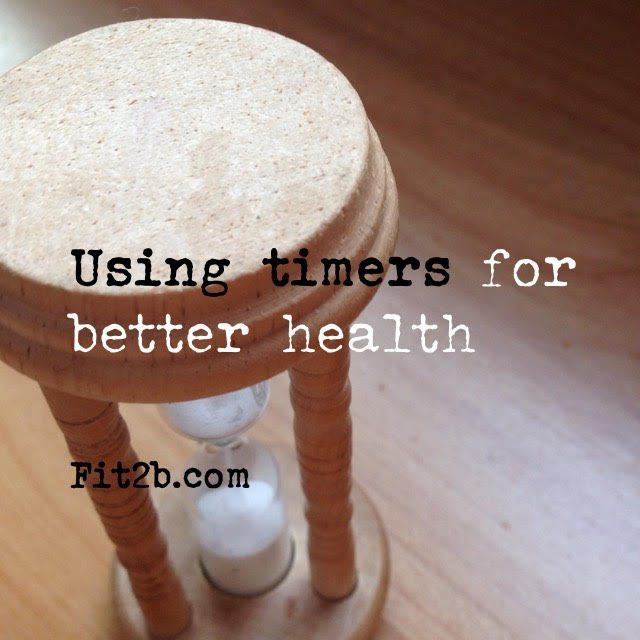Blog, Stretching & Flexibility
3 Times to Use Timers for Better Health & Fitness
Confession: My kitchen timer is seldom used for anything cooking related. As a fitness professional and healthier mom in the making, I tend to use timers for better health and wellness applications. Not that setting one to avoid burning dinner wouldn’t be healthier for my family, but this is the scoop on how my stove timer gets used the most.
Here are three ways that I use my stove timer, timer app, and kitchen timers to keep me and my family healthier. You might already be using these methods and others, and if that’s the case, I’d love you to leave a comment at the end of this blog!
1. Movement Breaks While I’m Working
This site provides diastasis-aware “TummySafe” workout routines suitable for all fitness levels BUT most people don’t realize that my work often involves more writing than working out. Some days, I spend hours working on new blogs, writing training programs, answer emails, drafting new content for eCourses like these… So setting my timer for 30 minute increments keeps me sane and moving. It’s going right now.

This blog is being written in chunks broken up by breaks so I can stretch, do a few squats, walk around while I talk on the phone, complete a couple chores, and then I go again. The timer is also my cue to change positions and switch to a standing work station if my last writing round was done while sitting. Like biomechanist and author Katy Bowman wrote, you need to Move Your DNA.
2. My LIIT and HIIT workout sessions
Timers come in very handy during HIIT-style workouts which stands for “high intensity interval training.” It’s very popular right now, and my colleague Dave Barnas who contributed the nutrition lesson for our “Experts on Diastasis Recti” eCourse did some thorough research on how HIIT can help you master your exercise genetics to improve your endurance and discussed it in this article. However, I’d like to stress that one person’s “high” training level will look completely different than another person’s “high.”
Most of the clients {not all} whom I work with are often recovering from birth, breastfeeding, or just returning to exercise after completing abdominal rehab. HIIT typically includes high-impact activities like sprinting and jumping, often leading to a decrease in milk supply for nursing mothers, increased width and depth of diastasis rectus abdominus, and increased symptoms of pelvic floor dysfunction such as urge or stress incontinence. Thus, I offer some LIIT – low intensity interval training methods on Fit2B to at least introduce the concept. Any interval that gets people above steady-state aerobic activity will help them firm up in safe ways, and then they can gradually increase the intensity of those intervals as their core and pelvic floor are ready to absorb additional impact. Sorry for the tangent… #notsorry …
Timer apps on smart phones can be set up to create intervals that are appropriate for any fitness level. If you’ve got a healthy core, go ahead and sprint or do box jumps for 1 minute followed by 2-3 minutes of walking, and repeat that 5-8 times. If you’re still recovering your core, your timer should be set for 15-20 second low-intensity intervals like squats or knee lifts followed by 3-4 minute active rests like walking. We have several cardio, Tabata, and kettlebell routines that would suit this method perfectly.
3. Brushing Teeth Long Enough to Actually Do Some Good!
I make my kids set a kitchen timer for 1 minute when they brush their teeth. As they get older, it’s time to make it 2 minutes. If I don’t make them time themselves, they will just give their pearly whites a few half-hearted swipes, spit and tell me their done. Timers let me point and say, “No, the timer says you’re not done yet.” Although it’s funny how it goes missing a lot…
Also related to tooth health, I use a timer for oil-pulling as well. I’m fascinated by all the uses for coconut oil. Swishing with it, then brushing my teeth with it has made a big difference in staining, random tooth aches, and my enamel feels so smooth afterward! I wrote about the funny side of oil pulling for Hybrid Rasta Mama here.
Okay! Okay! Fine! I admit it! I also use my timer to blackmail my kids into eating my terrible food. “You will finish that quinoa salad – even if you think it tastes like cardboard and cat food – in 10 minutes, or so help me Jesus, I’ll feed it to you for breakfast and you will not be able to watch Rescue Bots tonight!”
Just keepin’ it real, friends. Keeping. It. Really. Real. Because I’m not just the main face behind Fit2B’s workouts and core-friendly routines … I’m a real person who needs to keep herself (and her kids) motivated just like you.
Now tell me: how do you use your timer for things other than cooking? I’m curious to hear other health and fitness applications!


Very nice article Beth. I love how you pulled everything together. To your point on #3, brushing teeth. Several clients I’ve worked with over the years value balance training, particularly folks with aspirations of becoming more steady on their feet. As an at-home exercise, I often ask them to try and brush their teeth on 1 foot. One client tried this everyday for 2 weeks and noticed a significant improvement. She’s in her 70s. We validated her progress during her weekly workouts. Not sure how clean her teeth got or if she used a timer, but she’s feeling more confident on her feet and that goes along way in the later years of life. All the best!